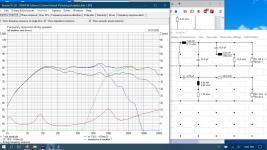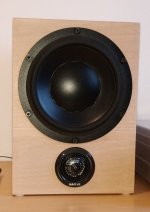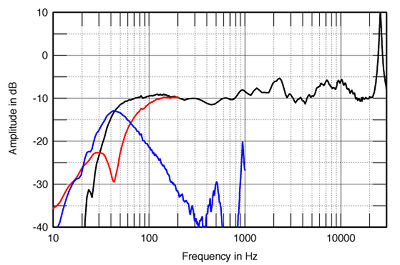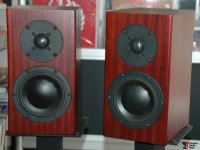I'm going to build a Totem Model 1 clone and I wonder if anyone has a diagram of the crossover.
I got the drivers pretty cheaply. Dynaudio 15W75-4 and Seas 25 TA/WGB-TO. Does anyone have the T/S for these drivers? I haven't had any luck searching online.
I'm new to crossover design so I'm going to design my own then compare to the original design. Any help appreciated.
I got the drivers pretty cheaply. Dynaudio 15W75-4 and Seas 25 TA/WGB-TO. Does anyone have the T/S for these drivers? I haven't had any luck searching online.
I'm new to crossover design so I'm going to design my own then compare to the original design. Any help appreciated.
Does anyone have the T/S for these drivers? I haven't had any luck searching online.
See post #6 Has anyone built a Totem Model 1 Clone?
The tweeters were modified by adding a back chamber at totem. There is some info on what is required somewhere on the internet but I can't remember where. I would be interested to see what they they did with the woofer in the crossover. According to Troels there are some resonances that need to be dealt with.
I haven't got a lot of stuff on that woofer:
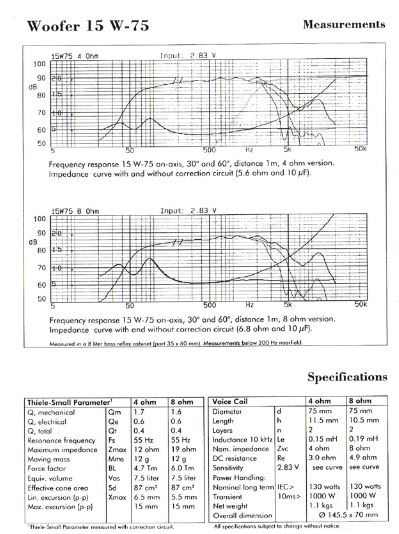
The bass filter is usually about 1mH coil and 4.7R plus 10-15uF impedance correction, relying mostly on natural rolloff. About 7-10L reflex you'd think. Dynaudio used to do quite complicated tweeter filters, but not set in stone IMO. Probably a third order would work well enough.
The tweeter is standardish 1" SEAS metal stuff. Shouldn't be too hard to knock up a 3kHz crossover. I'd set up a sim to see how it looks:
Software | Visaton
The Visaton SC10N is not hugely different from SEAS 1" tweeters. The W130S-4 might give you an idea too. After that you just wing it a bit.
SEAS 5INCH
The bass filter is usually about 1mH coil and 4.7R plus 10-15uF impedance correction, relying mostly on natural rolloff. About 7-10L reflex you'd think. Dynaudio used to do quite complicated tweeter filters, but not set in stone IMO. Probably a third order would work well enough.
The tweeter is standardish 1" SEAS metal stuff. Shouldn't be too hard to knock up a 3kHz crossover. I'd set up a sim to see how it looks:
Software | Visaton
The Visaton SC10N is not hugely different from SEAS 1" tweeters. The W130S-4 might give you an idea too. After that you just wing it a bit.
SEAS 5INCH
Last edited:
You're right on System7. Stereophile lists the volume as 7.2L.
Totem Acoustic Model 1 loudspeaker Specifications | Stereophile.com
The tuning appears to be 42Hz. I'll start dickering with Visaton and see what happens.
As far as a tweeter chamber goes- I didn't even notice the vented pole piece until I read your post martyh. Guess I have some googling to do.
Totem Acoustic Model 1 loudspeaker Specifications | Stereophile.com
The tuning appears to be 42Hz. I'll start dickering with Visaton and see what happens.
As far as a tweeter chamber goes- I didn't even notice the vented pole piece until I read your post martyh. Guess I have some googling to do.
I wouldn't losee too much sleep over a little back chamber on the tweeter, Just controls the Fs resonance a bit better. SEAS do it as standard these days:
H1147-06 27TBC/G
Your crossover will look a bit like this:
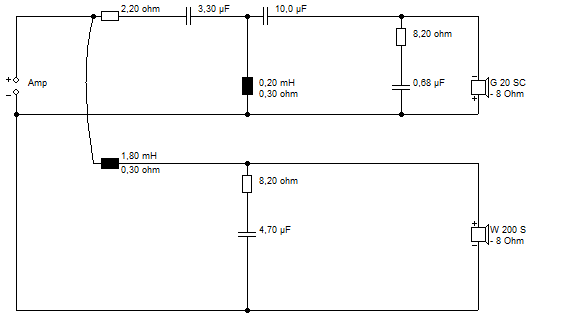
But different bass filter, drivers and positive polarity on tweeter. Shouldn't be hard to modify the default project in boxsim to see how it works.
H1147-06 27TBC/G
Your crossover will look a bit like this:
But different bass filter, drivers and positive polarity on tweeter. Shouldn't be hard to modify the default project in boxsim to see how it works.
Crossovers aren't hard. You just get the two drivers playing nicely together!
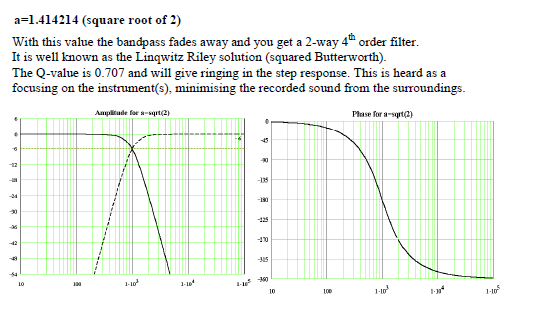
Troels Gravesen has done half the work here for you:

SEAS-3-Way-Classic
That's a reasonable 3.5kHz SEAS tweeter slope. It's going to sound good. Now you've just got to get the midbass to do the right things to join up.
The W130S-4 is a bit different from the 15W75-4, so stick to 1mH series followed by our guess of 4.7R and 15uF shunt for the bass. Dynaudio have done the work there already! No need to reinvent the bass filter.
The 1.4kHz lump in the W130S-4 is just what it does. We are only guessing here. Getting a feel for it all, you see. What I am hoping is if you get the tweeter to cross at about 3kHz for 6dB down, it should join up with the Dynaudio midbass.
Really, most 5" plus 1" speakers look the same.
Peerless HDS PPB 830860
You just fiddle with the details for particular drivers. Possibly R1011 and C1031 are the only two tweeter components that then need a little tweak.
Troels Gravesen has done half the work here for you:

SEAS-3-Way-Classic
That's a reasonable 3.5kHz SEAS tweeter slope. It's going to sound good. Now you've just got to get the midbass to do the right things to join up.
The W130S-4 is a bit different from the 15W75-4, so stick to 1mH series followed by our guess of 4.7R and 15uF shunt for the bass. Dynaudio have done the work there already! No need to reinvent the bass filter.
The 1.4kHz lump in the W130S-4 is just what it does. We are only guessing here. Getting a feel for it all, you see. What I am hoping is if you get the tweeter to cross at about 3kHz for 6dB down, it should join up with the Dynaudio midbass.
Really, most 5" plus 1" speakers look the same.
Peerless HDS PPB 830860
You just fiddle with the details for particular drivers. Possibly R1011 and C1031 are the only two tweeter components that then need a little tweak.
Last edited:
Great news, Ryan200!
We have a design or two... courtesy of no less than Mr. Troels Gravesen.
Didn't have to go far for some details.
Koapong - Esotar T330D & 15W-75
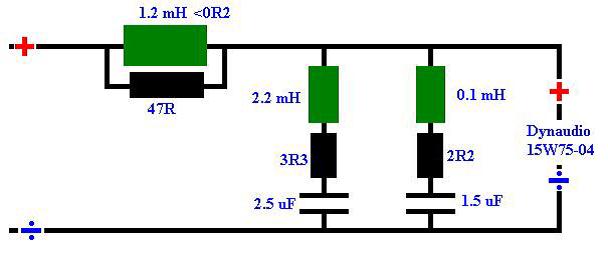

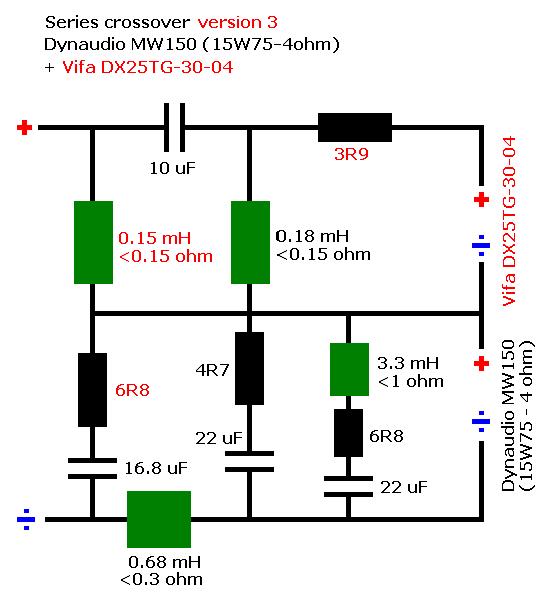
I think you can do something with that!
We have a design or two... courtesy of no less than Mr. Troels Gravesen.
Didn't have to go far for some details.
Koapong - Esotar T330D & 15W-75
I think you can do something with that!
Dynaudio Audience 42C that deployed 15W75-4 and a D28/2 like tweeter had a single coil as a LP filter for the woofer and a 2nd order electrical on tweeter. That much was sufficient for a good sounding loudspeaker. I would investigate a solution like that for the first crossover revision.
edit: this is my latest Dynaudio-Focal Auditor project
edit: this is my latest Dynaudio-Focal Auditor project
Attachments
Last edited:
I agree that a simple circuit has a lot going for it. Perfection can wait... 
So we have something like this:
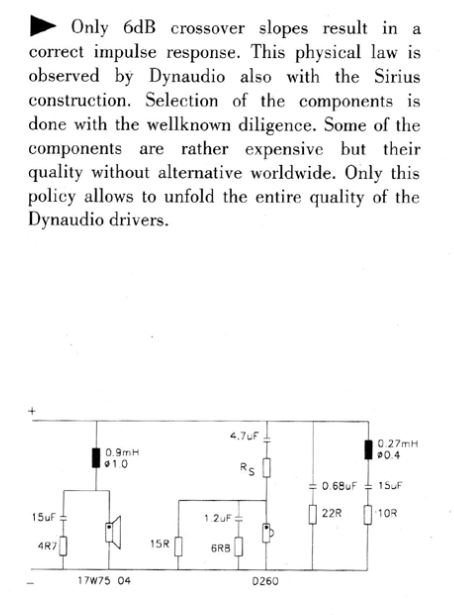
The two impedance corrections to the right will be optional. I expect a 0.3mH coil added would work for a second order tweeter. But that's a guess.
I have the 15W75 datasheet in front of me, and Dynaudio recommend 5.6uF and 10uF as the 4 ohm woofer impedance correction, 6.8 hm and 10uF as the 8 ohm impedance correction. Vas is 7.5L, Fs is 55Hz. Qts is 0.4.
Useful help here too:
Dynaudio Focus 110 and 140 Crossover Comparison Details
Crossover help needed for Dynaudio 17W75XL(ohm) and D260
Troels admits the parallel crossover is rather complex and a monitor or flat balance. The series filter is a more polite domestic slope, which he tends to call a BBC dip.
So we have something like this:
The two impedance corrections to the right will be optional. I expect a 0.3mH coil added would work for a second order tweeter. But that's a guess.
I have the 15W75 datasheet in front of me, and Dynaudio recommend 5.6uF and 10uF as the 4 ohm woofer impedance correction, 6.8 hm and 10uF as the 8 ohm impedance correction. Vas is 7.5L, Fs is 55Hz. Qts is 0.4.
Useful help here too:
Dynaudio Focus 110 and 140 Crossover Comparison Details
Crossover help needed for Dynaudio 17W75XL(ohm) and D260
Troels admits the parallel crossover is rather complex and a monitor or flat balance. The series filter is a more polite domestic slope, which he tends to call a BBC dip.
Last edited:
I agree. It's not great, but that is the Totem Model 1 sound.
Dyanaudio did better with the Focus 110:
SoundStage! Measurements - Dynaudio Focus 110 Loudspeakers (12/2006)
After some digging around, I found out enough about the Totem crossover to have a stab at this. It's second order around 2.9kHz.
The Totem bass filter looks resistance underdamped, hence peaky around 2kHz. Dyanaudio's impedance correction looks better. The woofer rolloff is quite steep. The hole at 4kHz comes from the shallow slope of the tweeter filter. Really third order would work best, IMO, but there it is.
So I reckon Ryan200 wants 1mH bass coil, and 4.7R or 5.6R plus 10-15uF shunt here. Tweeter filter might be about 5.6R plus 4.7uF, and 0.2mH shunt. Simple as that. Fiddle with the 5.6R for tweeter level. Always a matter of taste. I'd use a NP electrolytic in the bass filter.
Dyanaudio did better with the Focus 110:
SoundStage! Measurements - Dynaudio Focus 110 Loudspeakers (12/2006)
After some digging around, I found out enough about the Totem crossover to have a stab at this. It's second order around 2.9kHz.
The Totem bass filter looks resistance underdamped, hence peaky around 2kHz. Dyanaudio's impedance correction looks better. The woofer rolloff is quite steep. The hole at 4kHz comes from the shallow slope of the tweeter filter. Really third order would work best, IMO, but there it is.
So I reckon Ryan200 wants 1mH bass coil, and 4.7R or 5.6R plus 10-15uF shunt here. Tweeter filter might be about 5.6R plus 4.7uF, and 0.2mH shunt. Simple as that. Fiddle with the 5.6R for tweeter level. Always a matter of taste. I'd use a NP electrolytic in the bass filter.
Member
Joined 2009
Paid Member
The Totem Model 1 is a small two-way reflex design featuring a 5" Dynaudio midwoofer with a large cast-frame basket and a 3" voice-coil, a 1.1" metal-dome SEAS tweeter, and a very rigid cabinet. Joints are lock-mitered. An internal full-plane crossbrace further reinforces the cabinet, while sidewalls are made of a light material which quickly dissipates energy. Humid-type gaskets, which remain in a fluid state, are used around the drivers to ensure both damping and decoupling. Vince Bruzzese has further damped the entire structure by having the interior of the enclosure hand-painted with a thick, multilayer borosilicate paste. Similar compounds were used on the Space Shuttle to prevent the craft's heat-resistant tiles from breaking up due to vibration. The borosilicate is also used on the reflex tube, this made of a damped acrylic material, and set into place with anti-resonant glue.
The 1" metal-dome tweeter is highly modified at Totem before being installed in the Model 1. When it arrives from SEAS, Totem dismantles and rebuilds the tweeter, removing the front phase plug and modifying and damping the rear resonance chamber to match the woofer's. The design of the 125mm midwoofer includes a type of mechanical damping that prevents the unit from bottoming under extreme dynamic musical peaks. No grille is used, as Bruzzese is concerned that any air resistance will lead to mechanical compression of drivers.
The crossover is a quasi-second-order unit with a 2.7kHz electrical and mechanical crossover point. It utilizes Solen air-core Litz coils, metal-oxide resistors, and multiple bypassing of polypropylene capacitors with polystyrene types. All wiring employs specially wound oxygen-free-copper solid-core wire, and a silver-coated and extruded Teflon shield. WBT crimping methods and terminals are used, as well as WBT silver solder where appropriate. The heavy-duty, gold-plated WBT terminals each easily accommodate two spade lugs for bi-wiring. Fit and finish in this minimonitor is as good as I've seen in any dynamic loudspeaker. ... Stereophile
The 1" metal-dome tweeter is highly modified at Totem before being installed in the Model 1. When it arrives from SEAS, Totem dismantles and rebuilds the tweeter, removing the front phase plug and modifying and damping the rear resonance chamber to match the woofer's. The design of the 125mm midwoofer includes a type of mechanical damping that prevents the unit from bottoming under extreme dynamic musical peaks. No grille is used, as Bruzzese is concerned that any air resistance will lead to mechanical compression of drivers.
The crossover is a quasi-second-order unit with a 2.7kHz electrical and mechanical crossover point. It utilizes Solen air-core Litz coils, metal-oxide resistors, and multiple bypassing of polypropylene capacitors with polystyrene types. All wiring employs specially wound oxygen-free-copper solid-core wire, and a silver-coated and extruded Teflon shield. WBT crimping methods and terminals are used, as well as WBT silver solder where appropriate. The heavy-duty, gold-plated WBT terminals each easily accommodate two spade lugs for bi-wiring. Fit and finish in this minimonitor is as good as I've seen in any dynamic loudspeaker. ... Stereophile
Member
Joined 2009
Paid Member
- Status
- This old topic is closed. If you want to reopen this topic, contact a moderator using the "Report Post" button.
- Home
- Loudspeakers
- Multi-Way
- Help w/ Totem Model 1 homage
